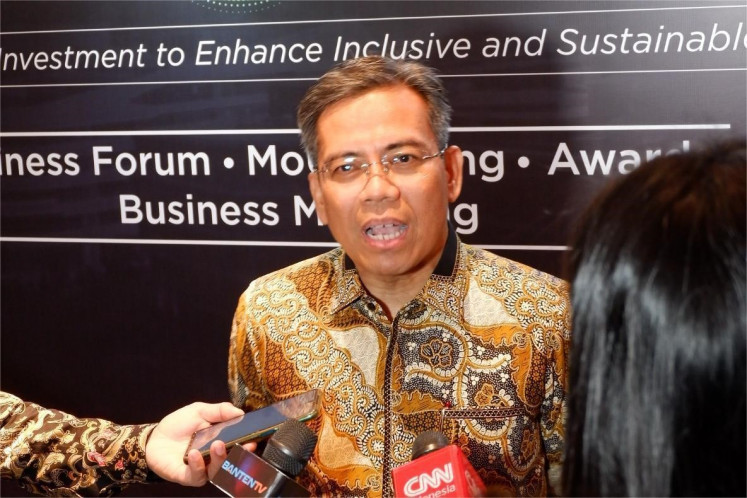Are insurance premiums really expensive? Here's the reality
Change text size
Gift Premium Articles
to Anyone

T
he ownership of insurance is increasingly recognized as a necessity for the Indonesian society in the post-COVID era. Insurance products are essential tools for individuals and their families to realize healthy financial planning.
However, there is still a common perception among the public that insurance premiums are expensive. This perception often arises because the impact of insurance products is not immediately visible to policyholders after paying a certain amount of money or a premium, as the guaranteed risk has not occurred.
Insurance is a crucial foundation of a healthy financial plan. Postponing or even neglecting insurance can make people vulnerable to risks that can be minimized. Although insurance cannot eliminate the potential risks that may occur at any time, it can reduce the financial losses that result from such risks. In other words, having insurance allows individuals to maintain their financial plans properly even if illness or accidents occur. The price for transferring the risk from the policyholder to the insurance company is the basis for calculating insurance premium prices. Insurance companies can anticipate potential losses that may arise from risks against the insured, which can occur at any time.
Therefore, the perception that insurance premiums are expensive is not entirely accurate. The value of insurance premiums varies for each individual. Quoting from Prudential PahamiBareng, the difference in premium prices is caused by the assessment of the risks faced by one policyholder compared to another. It is not surprising that the amount of money or premium to be paid, whether as a one-time or monthly payment, is determined by the insurance company based on the policyholder's circumstances.
Here are the interconnected factors and potential risks that will affect the value of a policyholder’s insurance premium:
- Age and gender
The age of the insurance policyholder is a determining factor in the amount of premium to be paid. The older someone is, the more expensive the premium they need to pay. This is because older individuals generally have higher health risks. Conversely, premiums are more affordable for younger policyholders because their health risks are lower. Therefore, it is highly recommended to purchase insurance while younger to have a relatively lower premium.
In addition to age, gender is another determining factor. In general, women pay higher premiums than men, considering other factors. This higher premium is caused by the fact that women are more likely to visit doctors for check-ups or use prescription drugs. The health risks for women are also higher than for men, one reason for which is childbirth.
- Habits and health history
Another determining factor for insurance premiums is an individual’s habits, or lifestyle choices that are related to health conditions. For example, active smokers tend to pay higher premiums because smoking is considered a lifestyle choice that can increase the risk of disease and death. Another example is individuals with excess body weight, who will pay higher health insurance premiums than those with a normal body weight.
In addition to habits, the policyholder's health history is also a determining factor. Policyholders with a history of chronic or congenital diseases tend to receive higher insurance premiums. Furthermore, the family health history is also considered by insurance companies in determining the premium amount, especially in health insurance products. Therefore, prospective policyholders are advised to purchase insurance when their health is still good. In good health conditions, the premiums to be charged are generally more affordable.
- Occupation and income
The next factor is the type of occupation or profession of the policyholder. The more complex and risky the profession, the higher the premium the policyholder needs to pay. Those working in mining and aviation, for example, will pay higher premiums because of the high risk of accidents and death.
In addition to the type of occupation, according to Prudential's PahamiBareng article, the amount of the policyholder's income is a determining factor in the premium amount. Policyholders are advised to choose insurance products with premium prices that match their needs and financial capabilities.
- Sum insured and policy contract period
The larger the sum insured for life insurance, the more expensive the premium that must be paid. This also applies to policyholders who purchase additional insurance or bring others onto the same policy. The more insurance added to the basic policy, the higher the insurance premium to be paid.
Moreover, the policy contract period also affects the amount of the premium set. The policy contract period refers to the agreed-upon life protection period between the insurance company and the policyholder. Insurance policy contracts are usually available for short terms, such as 5, 10 or 15 years, or even unlimited as long as the policyholder does not close the policy. Policyholders who choose shorter contract periods are likely to pay higher premiums compared to those who choose longer contract periods.
Therefore, policyholders need to carefully consider the amount of coverage needed and the policy contract period to ensure that insurance premiums are not overly burdensome and to obtain optimal protection benefits.
By looking at and understanding the factors that determine the amount of the premium, let us leave behind the perception that insurance premiums are expensive. Remember, insurance is for risk transfer, not for seeking profit, so let's buy life, health and accident insurance according to our needs and income.









